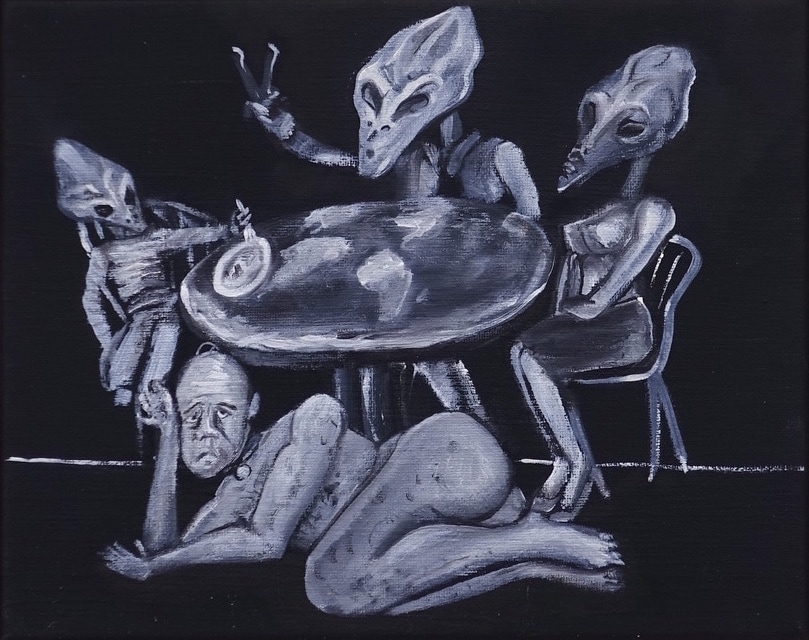Meet The Monster
Jamie Fletcher
Ian Hokin
R. Lord
Jonny Negron
March 16 + 17
Other Places Art Fair
Battery Leary-Merriam
Angels Gate Park
3601 S Gaffey St. San Pedro CA 90731
Hunter Shaw Fine Art presents Meet The Monster, a site-specific presentation of works by Jamie Fletcher, Ian Hokin, R. Lord, and Jonny Negron. Responding to the bizarre history of Battery Leary-Merriam, the location of Other Places Art Fair, and more famously, the so-called “Battle of Los Angeles,” Meet The Monster examines the role of the human mind in fabricating our fears and desires. The mind is both repository and breeding ground of information, misinformation, imagination, addiction, prejudice, and preference; this exhibition explores how these influences conspire to construct our subjective experience of consensus reality.
On the night of February 25 1942, citizens of greater Los Angeles were alarmed by reports of a “mystery invader” in the skies - an unidentified flying object had apparently breached the city’s airspace. With Pearl Harbor having taken place only two months prior, and wartime paranoia at an all time high, the military responded by calling an immediate citywide blackout, and lighting up the skies with convergent spotlight beams and an enthusiastic barrage from the anti-aircraft guns at Battery Leary-Merriam. Mysteriously, no wreckage was ever recovered although the skyward offensive lasted for over an-hour. Civilian reports of the incident ranged from mundane to fantastical, although everyone agreed the army had certainly fired at… something. Whatever the case, the “Battle of Los Angeles” captured the imagination not only of San Pedro residents - where a yearly re-creation of the event is staged - but also of a more widespread, conspiracy-minded community interested in uncovering a connection between extraterrestrials and the Military Industrial Complex
This line of thinking is explored in a series of small canvases by R. Lord, depicting the domestic life of an extraterrestrial family and their human pet, amongst other darkly comic, conspiracy-laden images. Across this body of work, the narrative is appropriately loose, associations relying on a feedback loop of niche information, cognitive gymnastics and near-rhyme relationships. In Little Blue Book (all works 2017), a flying saucer erases the text of the Bible and replaces it with information about NASA, conflating the Christian holy book with Project Blue Book (the notorious top-secret study of UFOs conducted by the United States Air Air Force, which has served as conspiracy theory jet fuel for decades.)
Hell (2013) by Jonny Negron plumbs a darker vein of nightmarish military conspiracy. The dense and cinematic drawing envisions the infernal torture of a POW at the hands of an ancient and demonic Nazi. In the foreground a laptop displaying lusty jpgs - perhaps some kind of evidence - is lost to the flames, while in the background, a figure absconds, youthful pigtails disappearing behind a wall of fire. This associative dread is stripped to its innermost elements in Negron’s Portishead (2012), a dystopian Narcissus in tight close-up. Enraptured by its own image, a figure intensely locks eyes with its reflection, the the tip of its nose hovering centimeters above a black puddle polluted with electronic waste. Rendered in the stark negative space of the raw page, the subject is detached from its environment, isolated by ego and mind.
The isolated mind is in fact the central focus in the practice of Ian Hokin, whose paintings are based upon visions he receives while floating in a sensory-deprivation tank. Free from external stimulation, the artist can sink through his own subconscious, and dive more deeply into the ocean of collective unconscious. From this realm emerge archetypal forces and primordial energies, which - like dreams - materialize in forms specific to the subconscious of the person perceiving them. For example, if the monster represents a primordial fear of the unknown, the mind creates the image of the monster, giving it a form culturally recognizable to the individual imagining it. Working with this symbolic visual language, Hokin’s paintings create an open system between creator, image and audience, where interpretation and meaning vibrate between familiar and foreign, euphoric and terrifying.
Jamie Fletcher also examines how complex mental states are materialized into subjective experience. Investigating the psychology of BDSM, Fletcher’s work explores the emotional and experiential ambivalence of consensual submission or domination, in which a participant may feel simultaneous arousal and humiliation, or pleasure and pain. Executed with a spare and expressive hand in bleach on black canvas, a pair of untitled paintings depict these hybrid states. In Untitled 1 (2013), a figure dripping in fluids stares directly at the viewer, a smug expression visible under a skin-tight mask. In the companion piece, a wild-eyed, messy-haired figure bares its teeth around a ball gag, its face urgent and intoxicated. Both images depict the manifestation of mindset, in which inner fears and desires are materialized through the experience of submission.
Although BDSM is an extreme example, our minds are constantly producing a self-image and worldview based on our fears and desires, while in turn projecting and experiencing a subjective version of consensus reality. What is projected influences what is experienced. Multiple viewers of the same incident may report drastically different interpretations based on the preferences they project. For nearly 80 years, the inconclusive and contradictory information surrounding the “Battle of Los Angeles” has fueled many Americans’ obsession with extraterrestrials, shaping their worldview, and undoubtedly influencing culture and politics from the Cold War to the present. Recent investigations into the “Battle of Los Angeles” suggest that there was, in fact, no invading aircraft, and that the military had actually orchestrated the event as a show of force to dazzle citizens and frighten any foreign enemies lurking off the coast. They had fired at nothing and the extraterrestrial rumors that followed were just icing on the cake. Setting the tone for Atom Age fears and speculations, Aliens became the latest manifestation of fear of the unknown. For many decades now, the military has allowed rumors and misinformation to guide the public’s perception of its activities, especially for those connecting the dots from San Pedro to Roswell to Area 51 and beyond. For the military, electing not to disprove or comment on these topics has the benefit of further obfuscating the truth about their enterprises, allowing the public’s imagination to produce erroneous conclusions which are never confirmed nor denied.

